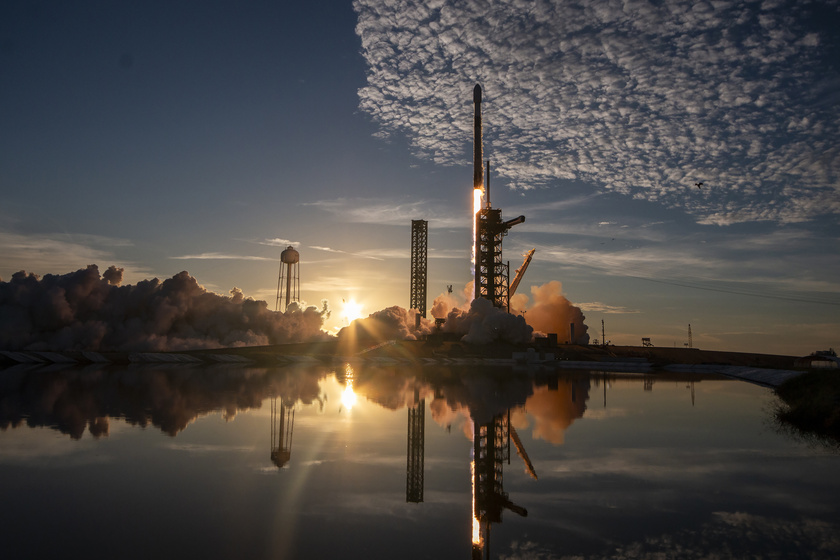A SpaceX Falcon 9 rocket successfully launched NASA’s Interstellar Mapping and Acceleration Probe (IMAP), the Carruthers Geocorona Observatory, and NOAA’s Space Weather Follow On-Lagrange 1 (SWFO-L1) spacecraft into an interplanetary transfer orbit on Wednesday, Sept. 24, at 1130 UTC from Launch Complex 39A at NASA’s Kennedy Space Center in Florida.
The launch, which had been delayed from September 23, was conducted during an instantaneous launch window with an 85% chance of favorable weather, and the Falcon 9's first stage booster, B1096, successfully landed on the droneship "Just Read the Instructions" in the Atlantic Ocean.
Falcon 9 will launch IMAP into a transfer orbit on its journey to the Earth-Sun L1 Lagrange Point – a gravitationally stable region 1.5 million km from Earth that offers clear vantage points to study the sun, space weather, and Earth's exosphere.
"There are three spacecraft on board today’s mission including @NASA’s IMAP and Carruthers Geocorona Observatory as well as NOAA’s SWFO-L1," SpaceX wrote on X. "Rideshare missions provide an opportunity to cost-effectively launch multiple spacecraft and maximize the amount of science sent to space on a single mission."
The primary payload, IMAP, was deployed approximately 1 hour and 23 minutes after liftoff, followed by the two rideshare payloads, SWFO-L1 and the Carruthers Geocorona Observatory, with each separation occurring about seven minutes apart.
The Interstellar Mapping and Acceleration Probe(IMAP) mission is the primary payload on today's flight, and is expected to answer four critical questions about the heliosphere and has a total cost of $782 million, including $109 million for the launch. The NASA mission led by Princeton University's David McComas as principal investigator, is designed to study the heliosphere, the protective magnetic bubble created by the solar wind that surrounds our solar system.
IMAP, weighing 900 kg, carries 10 different science instruments, is expected to answer four critical questions about the heliosphere. it will use to monitor solar activity as well as study interstellar dust and the solar wind, the stream of charged particles flowing continuously from our sun.
The spacecraft, will investigate the interaction between the solar wind and the local interstellar medium, understand particle acceleration processes, and measure neutral hydrogen atoms formed at the edge of the heliosphere.
The mission's data will also help scientists map the outer boundary of the heliosphere, the vast bubble around our solar system that's dominated by the sun's solar wind and magnetic field.
IMAP will also provide radiation warnings for astronauts — for example, those with NASA's Artemis program, which aims to establish a sustained human presence on and around the moon over the next decade or so.
"Radiation exposure is a real threat to our astronauts traveling to the moon and beyond," Nicky Fox, associate administrator of NASA's Science Mission Directorate, said during a news conference on Sunday (Sept. 21).
"Humanity has only ever existed inside our protective magnetosphere, and as we travel beyond that protective shield, whether it be to the moon or to Mars, the actionable information from missions like IMAP will keep our astronauts safe," she added.
IMAP will travel for 108 days to reach the Sun-Earth Lagrange Point 1 (L1), a gravitationally stable location about 1.5 million kilometers from Earth, where it will provide up to 30 minutes of warning before solar storms impact Earth.
Space Weather Early Warning System, SWFO-L1, developed by NOAA, is a dedicated satellite for continuous, operational space weather observations, succeeding older spacecraft like the Deep Space Climate Observatory (DSCVR), which has been offline since July 2025 due to technical glitches. It will provide crucial early warnings of solar storms that can disrupt satellites and power grids on Earth.
The spacecraft features four instruments, including a compact coronagraph and sensors for solar wind plasma and suprathermal ions, and will be renamed SOLAR-1 upon arrival at L1. NOAA will operate SWFO-L1 after its arrival, which is expected several months after launch.
The Carruthers Geocorona Observatory, originally named GLIDE, is a joint NASA/University of Illinois mission to study Earth's exosphere, the thin outer layer of the atmosphere extending halfway to the moon. It will image the geocorona, a faint ultraviolet glow produced by hydrogen atoms in the exosphere when they are excited by sunlight.
The mission was renamed in 2022 in honor of George Carruthers, the NASA scientist who designed the ultraviolet camera used during the Apollo 16 mission in 1972, which first revealed the geocorona.
The observatory's principal investigator is Lara Waldrop from the University of Illinois, and its instrument uses a modernized version of the process developed by Carruthers.
The small satellite "will image the faint glow of ultraviolet light from this region, called the geocorona, to better understand how space weather impacts our planet," NASA officials said in a mission description. "The Carruthers mission continues the legacy of the Apollo era, expanding on measurements first taken during Apollo 16."
The launch booster B1096 had previously flown on the Amazon Kuiper KF-01 mission in July 2025. Wednesday's Falcon 9 launch marked the 121st Falcon 9 mission of 2025 and the 539th overall, as well as the 220th orbital launch attempt worldwide in 2025. Most of these missions — more than 70% of them — have been dedicated to building out SpaceX's Starlink satellite-internet constellation in low Earth orbit.















